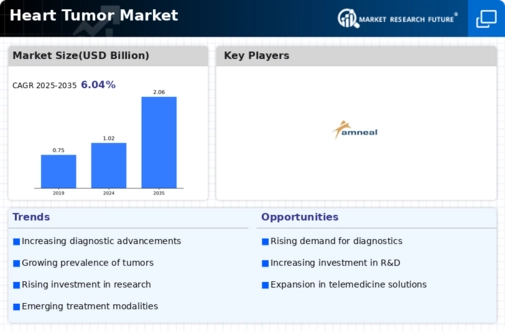Market Growth Projections
The Global Heart Tumor Market Industry is poised for substantial growth, with projections indicating a market size of 1.02 USD Billion in 2024 and an anticipated increase to 2.06 USD Billion by 2035. This growth trajectory suggests a compound annual growth rate of 6.61 percent from 2025 to 2035. Factors contributing to this expansion include rising incidence rates, advancements in diagnostic technologies, and increased research and development activities. The market dynamics reflect a growing recognition of heart tumors as a critical health issue, prompting stakeholders to invest in innovative solutions and improve patient care.
Increasing Incidence of Heart Tumors
The Global Heart Tumor Market Industry is witnessing a notable rise in the incidence of heart tumors, which is driving demand for effective treatment options. According to health statistics, the prevalence of primary cardiac tumors is estimated to be around 0.02 percent of all tumors, yet this translates to thousands of new cases annually worldwide. As awareness increases and diagnostic techniques improve, more cases are being identified, contributing to market growth. The industry is projected to reach 1.02 USD Billion in 2024, reflecting the urgent need for innovative therapies and interventions to address this growing health concern.
Advancements in Diagnostic Technologies
Technological advancements in diagnostic imaging and procedures are significantly influencing the Global Heart Tumor Market Industry. Innovations such as cardiac MRI, CT scans, and echocardiography have enhanced the ability to detect heart tumors at earlier stages, which is crucial for effective treatment. These technologies not only improve diagnostic accuracy but also facilitate better patient management. As a result, the market is expected to expand, with projections indicating a growth to 2.06 USD Billion by 2035. The integration of artificial intelligence in imaging is further expected to streamline diagnosis, thereby potentially increasing patient throughput and treatment initiation.
Rising Awareness and Education Initiatives
Awareness campaigns and educational initiatives regarding heart tumors are gaining momentum, significantly impacting the Global Heart Tumor Market Industry. Organizations and healthcare providers are increasingly focusing on educating the public about the symptoms and risks associated with heart tumors. This heightened awareness is likely to lead to earlier diagnosis and treatment, thereby improving survival rates. As more individuals seek medical attention for symptoms, the demand for diagnostic and therapeutic services is expected to rise, contributing to market growth. The industry is set to benefit from these initiatives as they foster a more informed patient population.
Growing Research and Development Activities
The Global Heart Tumor Market Industry is bolstered by increasing research and development activities aimed at discovering novel therapeutic approaches. Pharmaceutical companies and research institutions are investing heavily in clinical trials to explore new drug formulations and treatment modalities. This surge in R&D is likely to yield innovative therapies that can improve patient outcomes. The market is projected to grow at a compound annual growth rate of 6.61 percent from 2025 to 2035, indicating a robust pipeline of potential treatments that could reshape the landscape of heart tumor management.
Enhanced Treatment Options and Personalized Medicine
The Global Heart Tumor Market Industry is experiencing a transformation due to the emergence of enhanced treatment options, including personalized medicine. Tailored therapies based on genetic profiling and tumor characteristics are becoming more prevalent, allowing for more effective and targeted interventions. This shift towards personalized treatment is likely to improve patient outcomes and satisfaction. As the market evolves, the integration of these advanced therapies is expected to drive growth, with projections indicating a market size of 2.06 USD Billion by 2035. The focus on individualized care may also lead to increased investments in research and development.












Leave a Comment